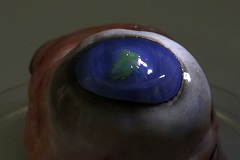Superman’s laser vision a step closer to reality

Superman’s ability to shoot laser beams from his eyes has come a step closer to reality, with discoveries made by a research team at the University of St Andrews.
Lasers on the eye – ocular lasers – may now be possible with the development of an ultra-thin membrane laser using organic semiconductors. They could be harnessed for new applications in security, biophotonics and photomedicine.
Writing in Nature Communications the researchers explainthat the threshold of their membrane lasers is compatible with the requirements for safe operation in the human eye. The team of Professors Malte Gather, Ifor Samuel and Graham Turnbull were also able to demonstrate ocular lasing using the cow eye as a model system.
The new laser approaches the fundamental limit in specific weight and thickness, as well as an exceptional mechanical flexibility, which allows to put them on a contact lens or a bank note.
 Professor Malte Gather of the School of Physics and Astronomy at the University said: “In ancient Greece, Plato believed that visual perception is mediated by ‘eye beams’ – beams actively sent out by the eyes to probe the environment.
Professor Malte Gather of the School of Physics and Astronomy at the University said: “In ancient Greece, Plato believed that visual perception is mediated by ‘eye beams’ – beams actively sent out by the eyes to probe the environment.
“Plato’s emission theory has of course long been refuted, but superheroes with lasers in their eyes live on in popular culture and comic books. Our work represents a new milestone in laser development and, in particular, points the way to how lasers can be used in inherently soft and ductile environments, be it in wearable sensors or as an authentication feature on bank notes.”
Professor Samuel said: “By floating a thin plastic film off a substrate we have made some of the world’s smallest and lightest lasers and put them on contact lenses and bank notes.”
The team also demonstrated that the devices were flexible and mechanically robust, even when attached to another object, and that their optical properties did not change over the course of several months.
They were then able to stick these ultra-thin lasers onto banknotes and contact lenses, where they suggest the devices could be used as flexible and wearable security tags.
“By varying the materials and adjusting the grating structures of the laser, the emission can be designed to show a specific series of sharp lines on a flat background – the ones and zeros of a digital barcode,” explained Markus Karl, who worked on the new lasers as part of his PhD.
Flexible organic optoelectronics – in particular for displays, photovoltaics and wearable sensors – is at the verge of large-scale commercialisation, with prototype devices already achieving staggering form factors and bending curvatures.
The newly developed membrane laser now completes this family of ultra-thin and ultra-flexible organic optoelectronic devices.
Photo captions
Homepage tile image courtesy of © Tetra Images/Getty Images
Top: laser on a £5 note
Bottom: laser on a contact lens on a cow’s eye
Additional photographs are available via Dropbox.
The paper Flexible and ultra-lightweight polymer membrane lasers by M Karl et al is published now in Nature Communications and available online.
Professor Malte Gather is available for interview via the Communications Office – contacts below.
St Andrews has an in-house ISDN line for radio and a Globelynx camera for TV interviews. To arrange an interview please contact the Communications Office in the first instance.
Issued by the University of St Andrews Communications Office. Contact Fiona MacLeod on 01334 462108, 07714 140 559 or [email protected].
Category Research